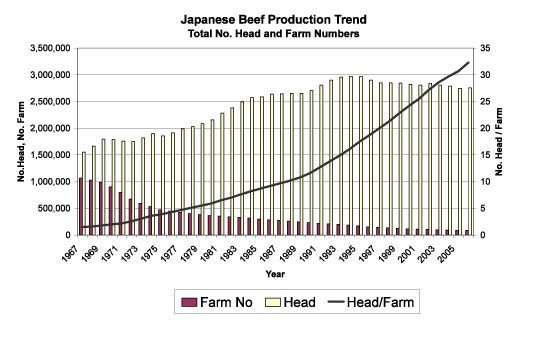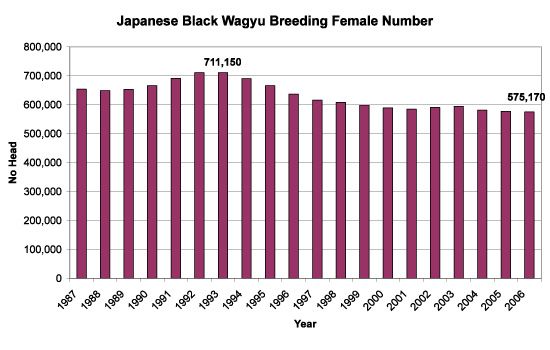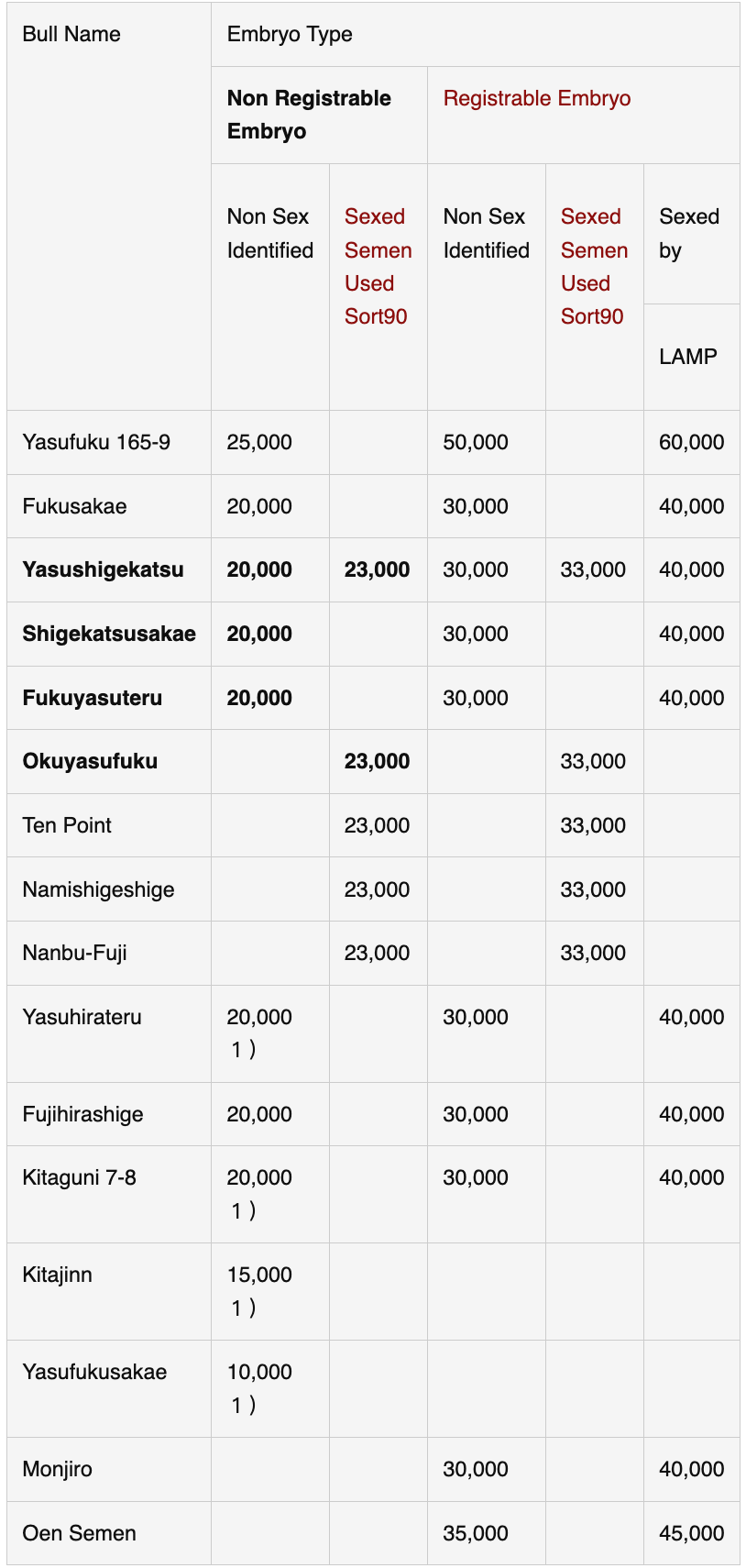Modern Wagyu Production Systems
Japanese fullblood Wagyu production is based on intensive management with minimal use of pasture. Virtually all joining is by artificial insemination. AI sire selection is extremely rigorous, starting with highly structured testing of potential AI bulls.
The limited diversity of sires is a core foundation of the consistent maintenance of desired carcass traits across the national herd, aptly illustrated by the extraordinary influence of a single bull in recent carcass competition results. The key production trends are towards increased growth and carcass weights with maintenance of high marbling.
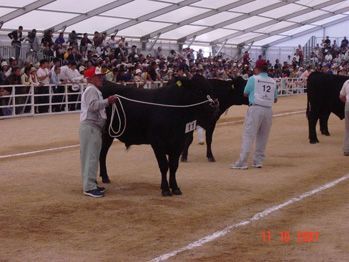
Wagyu Production Target Specification
Most contemporary fullblood production in Japan targets a 500kg progeny carcass (CW) graded to JMGA A4 from 75% or more of total progeny from each sire. Slaughter takes place at approximately 29 months of age, after 600 days on feed (DOF). This contrasts with a standard Australian fullblood 500-600 DOF CW of about 400kg, reflecting both intensive whole-of-life feeding and the use of high-growth/high carcass weight sires in Japan.
Japanese Wagyu AI Bull Selection
Modern sire selection practice typically combines Fujiyoshi, Kedaka and Tajima bloodlines to achieve a superior overall feed investment performance. (See Average Bloodline Composition of Calf Market Sires). The process of selecting AI bulls for the Japanese national Wagyu herd is managed by LIAJ.
(Livestock Improvement Association Japan) LIAJ is a corporate body made up of members from 42 prefectures, the Wagyu Registry Association (Zenwa), the Japanese Holstein Association, and the Agricultural & Livestock Industries Corporation.
LIAJ manages breeds bulls, manages progeny testing, publishes results, distributes semen, distributes veterinary drugs and manages traceability systems. Production of candidate bull calves is also undertaken by individual prefecture breed organisations and private breeding centres. About 40 new candidate bulls are entered into the progeny test every year.
The progeny test system consists of:
- The Direct Examination(not compulsory) – physical measurement of candidate AI sire performance commences at 12 months. Candidates are fed for two months with a uniform ration of 10% soybean meal, 20% Millrun, 35% Barley and 35% Corn. This enables objective measurement of both daily gain and feed efficiency. The young bull then enters the Indirect Examination phase with mating to a group of 8-35 female contemporaries.
- The Indirect Examination (compulsory) – focuses on progeny performance in both grow-out and carcass characteristics. Key parameters include:
Progeny Performance Measurement:
- Daily Gain
- BMS
- Loin Diameter
- TDN Requirement
- Subcutaneous Fat
- Slaughter Yield
- Carcass Weight
- Rib Thickness
- Meat Grading (4~5 %)
Test progeny are usually slaughtered at less than 24 months of age. Results of the completed tests bulls are published by ALIJ with an estimated Standard Breeding Values derived from the objective measurement process.
The entire selection cycle can take up to three years. Semen doses for new sires are generally priced from $10 ~. Established sires can remain in catalogues for many years, with some going back to 1993. Straws for ‘Super Sires’ can be priced to $1,000. Semen availability is then publicised in local prefecture bull catalogues, by the ALIJ and private breeding centres. Distribution is undertaken by registered artificial insemination technicians and registered veterinarians.
Note that selection for maternal characteristics/milking ability is limited as this is not an important requirement within the overall production regime. However, this does NOT mean Wagyu females cannot feed calves. Some prefecture bloodlines are noted for superior milking, but outside prefecture line-bred herds, assessment of individual animals is the best way to select for maternal capabilities.
Japanese Wagyu Cow/Calf – Trends and Technology
Wagyu Trends
Since 1955, the profile of the typical Japanese Wagyu cow/calf producer has changed from a small farmhouse operation averaging about 1.5 head per farm to an intensive medium size operation with about 35 breeders. A very large breeding herd would total about 120 females. In the same period, farm numbers declined 92% from 1,066,000 to 85,600.
With only about 1.4% of Japanese agricultural land under pasture (Longworth, 1981), cattle are raised intensively in sheds on rations of hay and grain, without any seasonal breeding pattern. Routine treatments include worming, clostridium vaccination and vitamin supplements.
Japanese Beef Procuction Trend
(Click for larger picture).
Wagyu Technologies
Joining is overwhelmingly by artificial insemination. In parallel, in utero embryo production and transfer has been used extensively to increase the speed of herd genetic improvement, with an important objective being production of superior females for feeder production herds.
More recently, in vitro embryo technologies have enjoyed buoyant demand – due to the decline of Japanese Black Wagyu breeding female numbers (see graph below) and, particularly, insatiable demand for a narrow band of high performance Wagyu genetics.
Japanese Black Wagyu Breeding Female Number
(Click for larger picture).
IVF technology has been available for over 20 years and is mainly associated with human artificial reproduction. (For a plain English explanation see: Lewis . Or: Gordon, I., 2003. ‘Laboratory Production Of Cattle Embryos’, 2nd Edtn. CABI.)
Only the very high prices available to cattle producers enable IVF application in contemporary Japanese commercial programs. (Comparatively, current fullblood prices in Australia predicate that even in utero ET calves sold as feeders usually generate a loss for the producer.)
In Japanese IVF programs, unfertilised embryos are often collected from fullblood females at slaughter. These embryos can be registered (where the female bloodline is identified) or unregistered (female bloodline is unknown). The embryos are fertilized in glass (in vitro), and either frozen for later transfer or prepared for immediate transfer.
As a result of the use of sexed semen (widely used in Western dairy production), undamaged, sexed embryos are available for either freezing or transfer. Embryos are frequently transferred into dairy cattle, extending a FB breeder herd de facto and maximizing the value of production from dairy breeders.
Comparatively, embryo sexing in standard in utero embryo production programs results in damage that normally demands immediate fresh transfer after flushing/sexing.
Non registerable embryos are used mainly in feeder cattle production programs; registrable embryos in breeding cattle programs. As the price list below indicates, this technology is now mainstream in Japanese Wagyu breeding programs. Prices in JP Yen.
Price List of IVF Embryos at LIAJ
(Click for larger picture).
A potentially negative aspect of this narrow genetic focus in Japanese Wagyu breeding is loss of genetic diversity. A number of scientific commentators have now identified the resultant inbreeding as a potential threat to the future of the Japanese Black herd.
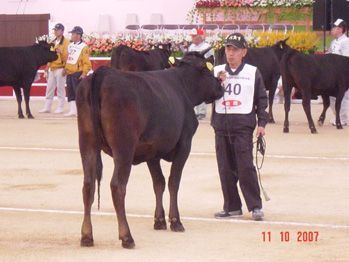
Early Wagyu Calf Grow-Out
Fullblood dams in Japan are not expected to feed calves to weaning. Nutritional supplementation of fullblood calves commences from about 10 days of age. A typical ration consists of corn, mill mix, soybean meal, roughage (Timothy, Bermuda grass, oaten hay and Italian ryegrass).
Key mineral and vitamin supplements include Vitamin A, D and E, calcium. The scale of the Japanese domestic market supports the production of manufactured pre-mixes suitable for the entire growth period. Typical calf premixes are formulated at CP:18-22%, TDN:72 ~ 74%. Fullblood calves are fully weaned at 4-5 months of age, 150 ~ 200kg.
Japanese Wagyu Feedlots
Most Japanese Fullblood feeders are finished by individual farmers rather than commercial feedlots. Farmers frequently combine rice cultivation, vegetable growing and beef cattle production. A typical large commercial Japanese feedlot contains about 500 cattle. A very large establishment might run to 15,000 head. Feeders are typically housed in close-sided barns with firm, sawdust-covered floors. Many smaller feeder barns are the size of an ordinary Japanese house.
Pen groups of 1-10 head are smaller than on most Australian feedlots to help regulate individual feed intake and reduce stress. Fullblood groups tender to be smaller than F1 groups. The number of square metres allocated per animal varies in Japan, compared with an Australian standard of about 12 m2. Feed consumption is highly controlled through out feeding period but water is available ad libitum. Fullblood feeder calves enter Japanese feedlots at about nine months of age and spend up to 600 days on feed.
Rations evolve through Starter, Grower and Finisher mixes. Weight gain commences at about 0.6 ADG to 12 ~15 months of age, then increases to 1.0 ADG to 18~20 months of age then reduces to 0.8 ADG at finishing. At about 28-31 months of age for fullbloods and about 27 months for crossbreds, feeders are slaughtered at facilities maintained by Japanese public authorities. Each carcass is assessed by JMGA inspectors and auctioned on an individual basis.
Buyers are able to inspect each carcass in chiller facilities prior to the auction and are provided with full details including Feedlot name, Carcass pedigree, Age, Sex, Weight and Grade. Carcass auctions are most frequently managed within the public abattoir system. Only registered brokers (buyers) can attend this carcass auction, acting as intermediaries to the retail, food service and trade channels.
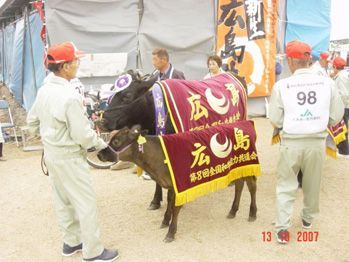
Japanese Wagyu Calf Markets
Calves are sold at auction on a individual basis at about 280 days of age, with a typical steer weight of 270 – 300 kg; heifer weight about 250.kg. Information for prospective feedlot buyers includes pedigree, date of birth, feeding and treatments history, current weight. Calf auctions are held fortnightly/monthly in indoor sales arenas throughout Japan, managed by regional cattle market authorities, with yardings ranging from 150-2000 head. Buyers can range from tiny 1-2 head fattening operations to a 7000-head feedlot. (A large feedlot in Japan holds about 15,000 head).
Sale is on individual ‘store’ not liveweight basis. In 2007, typical FB steer calf prices ranged from $AUD5000-5500.00; FB heifers $AUD4400-4600.00; XB (Holstein) steers $AUD2200-3000; XB heifers $AUD1500-$2300. About 360,000 head of fullblood and 80,000 head of crossbred calves are traded in this system in Japan each year. For typical 2011 prices see What’s a Wagyu worth?
Purebred Wagyu Production In Japan
Purebred Wagyu are a Western phenomena resulting from volume production requirements in the United States and Australia since the early 1990s. The crossbreed ‘grading up’ system from first outcross F1 through to F6 to achieve ‘purebred’ pedigree status is adopted from other Western breed society ‘breeding-up’ regimes targeting a specific pedigree status (EG: registered Boer goats in Australia can be bred up to full pedigree status over several generations using registered sires over non-Boer does at the first cross).
The system enables relatively rapid and inexpensive production of large breeding herds. It can also target the enhancement of traits perceived important in extensive pastoral systems (EG: maternal capabilities, tropical adaptation). Successful and consistent results within a herd are dependent on selection rigor (on the female side in particular). Given numerous outcross options, individual herd results might be expected to vary significantly. There is no Japanese equivalent to Australian purebred Wagyu herds.
Let’s Talk About Your Wagyu Breeding Plan
We'll Find the Right Wagyu Breeding Solution for You
Call us:

